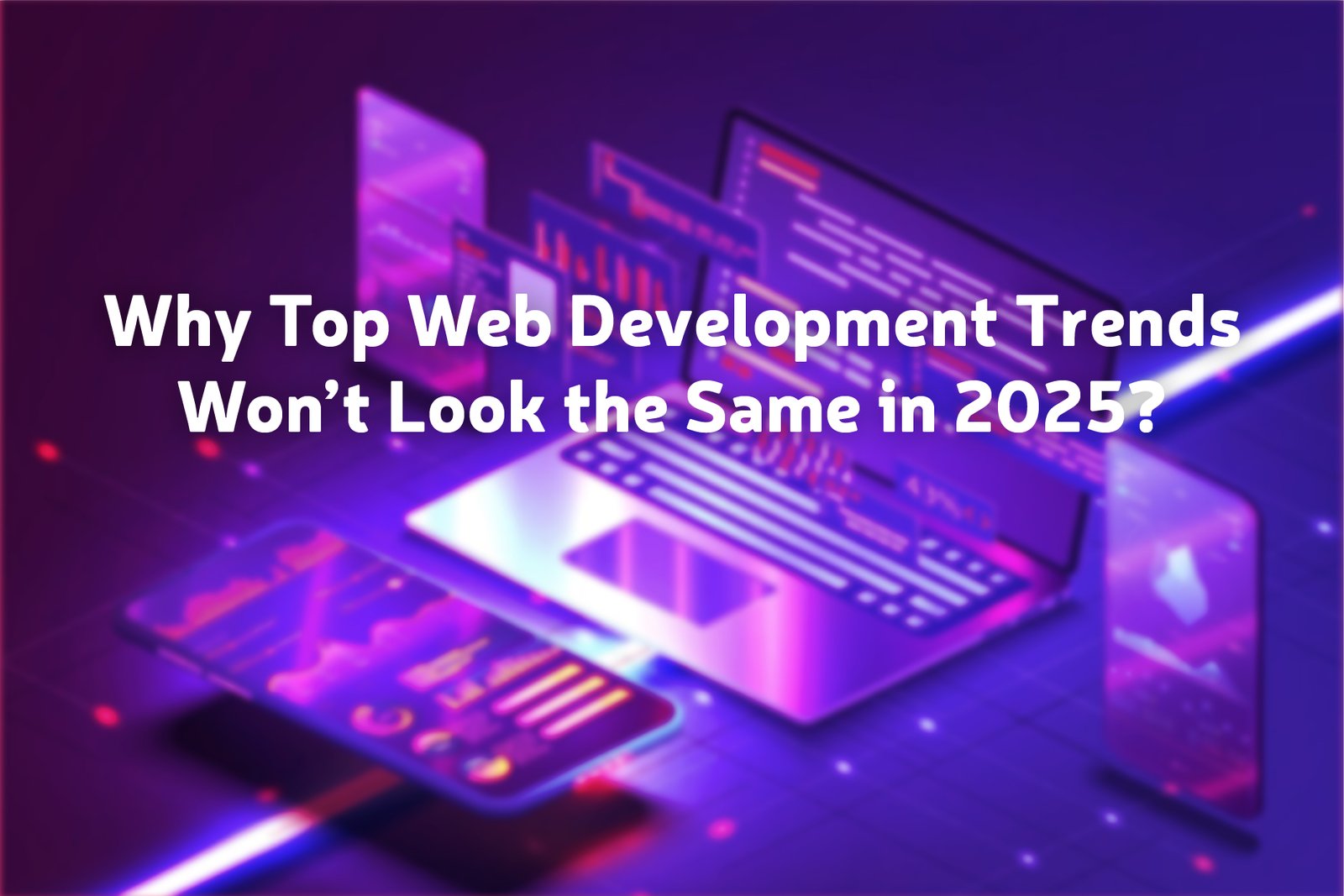As of 2025 there will be above 1.1 billion websites on the globe, and 38 percent of developers are trying to hone their web development skills, putting that at the very top of tech professionals’ wish lists in terms of aspirations.
But this isn’t just about learning to code; it is more about implementing the latest tools and tech. Websites are no longer static pages; they are becoming intelligent and interactive platforms that change with the user’s needs in real time.
Without any further delay, let’s talk about the 10 top web development trends that are taking web development in 2025 to the next level.
List Of 10 Top Web Development Trends 2025
1. AI-Powered Web Experiences
The inception of Artificial Intelligence has made lives easier. It is incorporated in every field, such as Web development. It is taking it up a notch with:
– Personalized Content: Websites smartly adjust or adapt content based on your behavior and preferences.
– AI-Assisted Development: Tools like GitHub Copilot aid developers by suggesting code snippets, increasing productivity.
– Enhanced User Interaction: The inclusion of AI-powered chatbots and voice assistants provides real-time support and engagement. For instance, Peloton utilizes AI chatbots to assist customers with orders and equipment inquiries.
2. Progressive Web Applications (PWAs)
One of the coolest changes in 2025 is how websites act more like mobile apps. These are called Progressive Web Apps, or PWAs. Imagine you open a website that loads instantly, works offline, and even sends you push notifications—just like a regular app on your phone. That’s a PWA.
Take Twitter Lite, for example. It’s a PWA that works nicely even on slow connections and low-end phones- all this with the help of service worker attributes. For users in countries where data is expensive or Wi-Fi is spotty, this makes a huge difference. More businesses are jumping on this trend because it’s cheaper than building separate apps for Android and iOS. Moreover, it is way easier to update.
Businesses are increasingly adopting PWAs to deliver efficient and engaging user experiences. Recently, Apple expanded PWA support on iOS, which allowed third-party browsers to create home screen web apps using their own search engines.
3. API-First Development
An API-first approach emphasizes designing robust APIs before developing the application, ensuring:
– Scalability: It provides easier integration with various platforms and services.
– Flexibility: Facilitates the development of diverse front-end applications.
– Efficiency: Simplify the development process by decoupling front-end and back-end systems.
This method is getting more standard in modern web development trends.
4. Headless CMS Architecture
Headless Content Management Systems (CMS) decouple the content repository from the presentation layer. In simple words, think of a website where content (like blog posts, images, and product info) lives separately from the design. That’s what a Headless CMS does. It’s like having a brain that isn’t tied to one body—it can send the same content to multiple platforms at once.
Services like Strapi are leading this shift. They let developers build fast, customizable websites while allowing marketers and editors to update content without touching code. It’s faster, safer, and way more flexible than traditional WordPress-style sites.
5. Enhanced Cybersecurity Measures
In 2023 alone, over 2,200 cyberattacks happened every day. That’s nearly one every 40 seconds. So, in 2025, secure websites are not an option; it’s compulsory for every business.
Developers are baking in better encryption, two-factor authentication, and real-time threat detection. More websites are also being built with Zero Trust Architecture, which assumes no device or user is safe until proven otherwise. You’ll notice more websites prompting you to verify your identity, and while that might feel annoying, it’s actually protecting you.
Thus, cybersecurity is extremely significant to maintaining user trust and safeguarding digital assets.
6. Voice Search Optimization
Because of Alexa, Siri, and Google Assistant, voice search is becoming second nature. And this year, in 2025, experts estimate that half of all online searches will be based on voice search.
Web developers are optimizing sites so they can answer voice queries naturally. This means writing content that sounds more like how we speak (instead of robotic keyword-stuffing), and adding special code (called schema markup) so search engines understand it better.
So if you say, “Where’s the best sushi near me?” your voice assistant won’t just find random sushi, it’ll find one that’s open, nearby, and has good reviews. Websites that aren’t optimized for voice? They’ll just get left behind.
7. Blockchain Integration (It is not just for crypto anymore)
When most people hear “blockchain,” they think Bitcoin. But in 2025, blockchain is being used for a lot more than digital currency. It’s helping developers build websites that are more secure, transparent, and decentralized.
For example, blockchain lets users log in without passwords, using secure identity tokens instead. It also makes sure that sensitive data (like medical records or financial info) can’t be tampered with.
Morevoer, it offers smart cotracts. It is a self-executing digital agreement that crosses out the need to trust the middleman. This also makes the transaction and process faster, cheaper, and more truthful.
And for e-commerce? Blockchain can make supply chains more visible and prevent fraud. This technology is especially big in industries like healthcare, finance, and logistics, where trust and data accuracy are everything.
8. Virtual and Augmented Reality (VR/AR)
Do you remember the time when websites were just text and images? However, now we’re seeing augmented reality (AR) and virtual reality (VR) show up on product pages, educational sites, and even real estate listings.
IKEA lets you “place” furniture in your living room using your phone camera. Educational websites are offering VR tours of historic landmarks. There is a website called Virtual Tour, which allows you to go to any country from the comfort of your desk. You can fly, walk around, and drive to many cities. This shows that in 2025, this tech will go beyond fun; it’ll be a way to experience the internet, not just browse it.
9. Mobile-First Design
Almost around 60 percent of web traffic now comes from mobile phones. That means developers have flipped the script: they now design websites for mobile first, and desktop second.
A mobile-first site loads faster, scrolls smoother, and fits your screen perfectly—no more pinching and zooming just to read a menu. Google even ranks mobile-optimized sites higher, so it affects visibility too. Therefore, with a mobile-friendly design, you can reach your potential customers more effectively by improving their experience on your website.
10. Serverless Architecture
Finally, 2025 is seeing a boom in serverless architecture. Don’t worry, it doesn’t mean websites have no servers. It means developers don’t have to manage them. Platforms like AWS and Google Cloud handle all the behind-the-scenes work.
This helps websites scale faster and cost less with the help of a pay-as-you-go model. Imagine running a business site that gets 100 visitors today and 10,000 tomorrow, the serverless systems automatically adjust, so you don’t crash or pay extra.
To Sum Up
The web in 2025 is faster, smarter, and more interactive than ever. But more importantly, it’s becoming more human-designed around how we think, talk, and live. If you’re a developer, this is your chance to build the future. Or if you are a business owner or user? Keep an eye on these 10 top web development trends—because your experience online is about to get a serious upgrade.
Frequently Asked Questions (FAQs)
What is the future of web development in 2025?
The future of web development trends will take the niche decentralized technologies to the wide implementation. The most important tool is blockchain technology. Other than that, future trends include mobile-first designs, PWAs, API-first designs, etc. If you are looking for one of the futuristic and innovative top web development companies, then I recommend you visit Cognitive IT Solutions for your web development services to increase your website’s user experience.
Is web design worth it in 2025?
Yes, web design holds great significance even in 2025. And this file is also constantly evolving, just like other fields. So, make sure to incorporate the newest technologies to stay ahead of your competitors.
Will web developers be in demand in 2030?
Yes, no, just an average demand, but it is expected to grow by 8% by 2030, according to the Bureau of Labor Statistics.
Will AI replace web developers?
AI is leveling up everything like web development trends, but that doesn’t mean it can completely replace web developers. AI is powerful, but there are aspects like creativity, problem solving, and human touch that these AI tools lack.
What is the latest technology for web development?
The latest technology of website development includes AI, PWAs, cloud computing, blockchain technology, and web programming.
What is the latest programming language used in web designing?
There are many programming languages used in web design. However, the most popular and versatile is JavaScript.
What are the new trends in web development?
The new trends in website development include AI integration, voice search optimization, API first design, mobile-first design, blockchain integration, and many more.
How to increase page speed?
The top things the web developer can do to increase page speed are image optimization, minify & compress code, leverage caching, use a content delivery network, reduce HTTP requests, and more.










